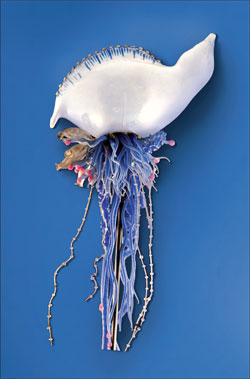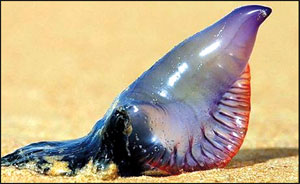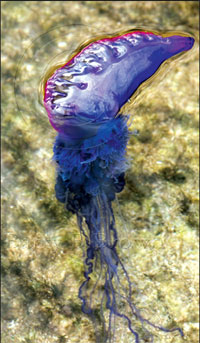|
Portuguese Man-of-War:
A jellyfish or not?
 Most
of you must have heard of a particular group of marine creature known as
jellyfish. Some of you may have even had nasty experiences by coming
into contact with certain species of jellyfish on the beach which are
said to be harmful,Today we like to introduce you to a marine species,
an invertebrate called the Portuguese Man-of War (Physalia physalis)
that is considered to be very venomous, and many mistake them for
jellyfish. Most
of you must have heard of a particular group of marine creature known as
jellyfish. Some of you may have even had nasty experiences by coming
into contact with certain species of jellyfish on the beach which are
said to be harmful,Today we like to introduce you to a marine species,
an invertebrate called the Portuguese Man-of War (Physalia physalis)
that is considered to be very venomous, and many mistake them for
jellyfish.
What is interesting is that the Portuguese Man-of-War not only isn't
a jellyfish but is also not a single entity. So, the Portuguese
Man-of-War is not even an "it," but a "they" and is called a
siphonophore, an animal made up of a colony of organisms working
together.The siphonophore, differ from jellyfish as they are not
actually a single creature, but a colonial organism made up of many
minute individuals called zooids.Each of these zooids is highly-specialised
and, although structurally similar to other solitary animals, are
attached to each other and physiologically integrated to the extent that
they are incapable of independent survival.
|

The gas-filled bladder. |
The Portuguese Man-of-War are composed of four types of polyp.These
polyps are "clustered".One of the polyps, a gas-filled bladder called
the pneumatophore (commonly known as the marissa or sail), enables the
organism to float. This sail is translucent and tinged blue, purple,
pink or mauve. Sometimes these animals are also called bluebottles for
the purplish blue colour of their pneumatophores.
The sail may be 9 to 30 centimetres (4 to 12 in) long and may extend
as much as 15 centimetres (6 in) above the water. The gas which the
Portuguese Man of War secretes into its sail has approximately the same
composition as the atmosphere, but may build up a high concentration of
carbon dioxide (up to 90per cent).
The sail must stay wet to ensure survival and occasionally they may
roll slightly to wet the surface of the sail. To escape a surface
attack, the sail can be deflated allowing the Man-of-War to briefly
submerge.
The other three polyps are known as: dactylozooid (defence),
gonozooid (reproduction), and gastrozooid (feeding). They make up the
tentacles that are typically 10 metres (30 ft) in length but can be up
to 50 metres (165 ft).
The Portuguese Man-of-War tentacles are made up of threa ployps is
classified as a carnivorous species uses venomous tentacles to trap and
paralyse the prey that consists mostly of small crustaceans, small fish,
algae and other members of the surface plankton. In general it has been
observed that the creatures eat

The bladder is above the water. |

Floating in the sea. |
basically anything that comes in contact with the stinging tentacle
polyps,the dactylozooids. The long tentacles "fish" continuously through
the water and each tentacle bears stinging venom-filled nematocysts
(coiled thread-like structures), which sting and kill small sea
creatures such as small fish and shrimp.
Contractile cells in each tentacle work to drag prey into the range
of the digestive polyps, the gastrozooids, another type of polyp that
surround and digest the food.Muscles in each tentacle contract and drag
prey into range of the digestive polyps, the gastrozooids, which, acting
like small mouths, consume and digest the food by phagocytosis - by
secreting a full range of enzymes that variously break down proteins,
carbohydrates and fats. Gonozooids are responsible for reproduction.
|

The tentacles. |
Why is this creature known as the Portuguese Man-of-War?According to
scientists the name comes from the uppermost polyp, the gas-filled
bladder, ( pneumatophore), which sits above the water that resembles an
old warship at full sail. The gas-filled bladder, remains at the
surface, while the remainder is submerged. Sometimes these animals are
also called bluebottles for the purplish blue colour of their
pneumatophores. The tentacles, the creature's second organism are long,
thin tendrils that can extend up to 165 feet (50 metres) in length below
the surface, although 30 feet (10 metres) is more the average.
The species of Portuguese Man-of War is often found with a variety of
marine fish, including shepherd fish, clownfish and yellow jack, species
that are rarely found elsewhere. Man-of-War are found, sometimes in
groups of 1,000 or more, floating in warm waters throughout the world's
oceans. They have no independent means of propulsion and either drift on
the currents or catch the wind with their pneumatophores. Do you know
that they have the ability to deflate their air bags and briefly
submerge to avoid threats on the surface?
The Man - of - War are found in warm water seas floating on the
surface of open ocean, with the air bladder keeping them afloat and
acting as a sail while the rest of the organism hangs below the surface.
They are most common in the tropical and subtropical regions of the
Pacific and Indian oceans, but can drift outside of this range on warm
currents such as the Atlantic Gulf Stream.
An abundance of them can be found in the waters of Costa Rica,
especially in March and April, while they are also found off of Guyana.
They wash up on the shore during certain months of the year. They are
reported abundantly in the waters near Karachi, Pakistan in the summer
months, and are also common in the ocean off parts of Australia, where
they are known more commonly as 'blue-bottles', and New Zealand. They
are also frequently found along the east coast of South Africa,
(particularly during winter storms if the wind has been blowing steadily
on-shore for several hours), as well as around the Hawaiian Islands.
Strong onshore winds may drive them into bays or onto beaches.
It is rare for only a single Portuguese Man o' War to be found; the
discovery of one usually indicates the presence of many as they are
usually congregated by currents and winds into groups of thousands.
[Fast facts]

* The tiny Nomeus gronovii fish is immune to the sting of the
Portuguese Man-of-War. It lives among the tentacles and even snacks on
the stinging tendrils.
* The species is a jelly-like marine invertebrate of the family
Physaliidae.
* The name " Man-of-War" is taken from the man-of-war, a 16th century
English armed sailing ship which was based on an earlier Portuguese
vessel.
* The Man-of-War comprises four separate polyps.
* The Man-of -War have no means of propulsion and move by a
combination of winds, currents, and tides. They move by means of their
crests,that functions as a sail.
 *
The stinging tentacles (nematocysts) can cause extremely painful stings,
shock, and in certain instances, death.Detached tentacles and dead
specimens (including those that wash up on shore) can sting just as
painfully as the live creatures in the water, and may remain potent for
hours or even days after the death of the creatures or the detachment of
the tentacle. *
The stinging tentacles (nematocysts) can cause extremely painful stings,
shock, and in certain instances, death.Detached tentacles and dead
specimens (including those that wash up on shore) can sting just as
painfully as the live creatures in the water, and may remain potent for
hours or even days after the death of the creatures or the detachment of
the tentacle.
* For humans, a Man-of-War sting is excruciatingly painful, but
rarely deadly. But beware-even dead ones washed up on shore can deliver
a sting.
* They are carnivorous species and the muscles in the tentacles draw
prey up to a polyp containing the gastrozooids or digestive organisms.
Facts and pix: Internet |

